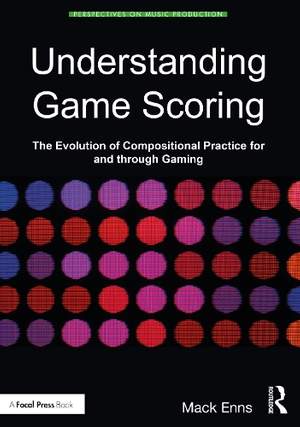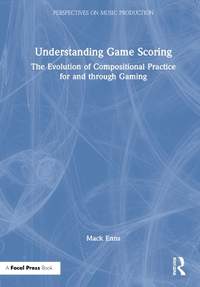
Understanding Game Scoring: The Evolution of Compositional Practice for and through Gaming
- Author: Enns, Mackenzie
Book
$62.00Printed on demand
Contents
- Contents
- List of Tables
- List of Figures
- Chapter 1 An Introduction to Game Scoring
- Disasterpeace and FEZ: A Case Study of Game Scoring
- Music System Overview: Sequence Context Menu
- Music System Overview: Scripts Browser
- Music System Overview: Main Composition Sequencer
- Game Scoring as an Unique Mode of Musical Composition
- Methodology and Outline
- Bibliography
- Chapter 2 Game Scoring's Interactive Multimedia Context
- Spatial Emulation, the "Gaming Diegesis" and Game Scoring
- Interactivity: A New Element
- Audial Responsibility in the Interactive Multimedia Text: A Case Study of the Score for The Legend of Zelda (1987)
- Case Study Conclusions: Williams, Cage and Game Scoring as Aleatoric Composition
- Game Scoring Taxonomy: Title Music
- Game Scoring Taxonomy: Source Music
- Source Music Case Study: Kondo's "Lost Woods" Vs. Vreeland's "Reflection"
- Game Scoring Taxonomy: Results Music
- Chapter Conclusions
- Bibliography
- Chapter 3 Game Scoring and Gaming Technology
- Case Study: The Nintendo Entertainment System's Sound Hardware Configuration
- Channel Overview: Pulse Wave Channels
- Channel Overview: Triangle Wave Channel
- Channel Overview: Noise Channel
- Channel Overview: Delta Modulation Channel
- NES Game Scoring Techniques
- NES Game Scoring Techniques: 2-Channel Echo
- NES Game Scoring Techniques: Single Channel Echo
- NES Game Scoring Techniques: Arpeggio & Psychoacoustic Block Chords
- NES Game Scoring Techniques: TWC Kick Drum Sounds
- NES Game Scoring Techniques: Melodic Samples
- Putting It All Together: The APU Mixer
- Case Study Summary
- Game Scoring Taxonomy: Logo Jingles
- Game Scoring Taxonomy: Loading Music
- Game Scoring Taxonomy: Voice Acting and Vocals
- Chapter Conclusions
- Bibliography
- Chapter 4 Game Design and Game Scoring as Software Programming
- Game Scoring Taxonomy: Introduction Music
- Game Scoring Taxonomy: Demo Music
- Game Scoring Taxonomy: Gameplay Music
- Gameplay Music: Hub Music
- Gameplay Music: Area Music
- Area Music Case Study: Game Scoring as Mimetic Music Technology in Tetris (1984) and Guitar Hero (2005)
- Gameplay Music: Area Music, cont.
- Gameplay Music: Time System Jingles
- Gameplay Music: Battle Music
- Gameplay Music: Rest Music
- Gameplay Music: Dialogue Music
- Dialogue Music Case Study: The Owl and The Legend of Zelda: Link's Awakening (1993)
- Gameplay Music: Challenge Music
- Chapter Conclusions
- Bibliography
- Chapter 5 Game Scoring: Gameplay as Performance of Aleatoric Composition
- Before Video Games: The Aleatoric Tradition
- A Note on Sound Effects
- Case Study: Super Mario Bros. (World 6-2)
- Game Scores Vs. Game Soundtracks: Super Mario Bros. on CD
- Case Study Conclusions
- Game Scoring Taxonomy: Menu Sound Effects
- Mario Menus: A Case Study of Menu Sound Effects in Two Super Mario Games
- Menu Sound Effects, Cont.
- Game Scoring Taxonomy: Menu Music
- Game Scoring Taxonomy: Status Music (Gameplay Music, Cont.)
- Game Scoring Taxonomy: Gameplay Sound Effects
- Game Scoring Taxonomy: "Ambiences" or Ambient Sound Effects
- Chapter Conclusions
- Bibliography
- Chapter 6 Game Scoring: Conclusion
- Future Directions
- Significance
- Implications
- Conclusion
- Bibliography
- Index



